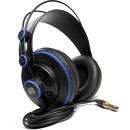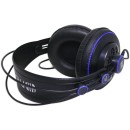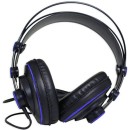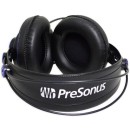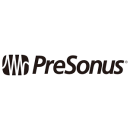PreSonus HD7 Monitoring Headphones Review
- Wearing Style: Dual Ear with Headband
- Foldable: No
- Earpiece Swivel: No
- Open/Closed-Back: Semi-Open-Back
- Impedance: 32 Ohms
- Active Noise Cancellation: No
- Frequency Response: 10 Hz to 30 kHz
- Built-In Mic: No
- Audio Connector: 1x 1/8" / 3.5 mm TRS
- Included Adapter: 1/4"
Detailed Analysis of PreSonus HD7 Features and Performance
The PreSonus HD7 Monitoring Headphone is a high-quality audio accessory designed for professional audio monitoring. With a semi-open-back design, these headphones deliver a natural and spacious sound, making them ideal for studio use and critical listening. The design allows users to experience a more realistic audio environment, providing a unique blend of open-back acoustics and the isolation of closed-back headphones.
Featuring a frequency response range of 10 Hz to 30 kHz, the PreSonus HD7 ensures that every detail in the audio spectrum is captured and delivered with precision. The headphones have an impedance of 32 Ohms, making them compatible with a wide range of audio devices, providing excellent performance whether connected to professional studio equipment or consumer-grade electronics.
The PreSonus HD7 does not include active noise cancellation or a built-in microphone, focusing instead on delivering pure, unaltered sound. The headphones come with a 1/8" (3.5 mm) TRS audio connector and an included 1/4" adapter, ensuring compatibility with various audio interfaces and equipment. With a comfortable dual ear wearing style and headband design, the PreSonus HD7 is built for extended listening sessions.
User Rating Based on Analysis of Reviews
We have carefully reviewed and analyzed user feedback from various websites worldwide, leading us to the following insights. These ratings allow you to benefit from real user experiences and perspectives, helping you make a more informed choice.
Sound Quality
80% of users were satisfied with the sound quality of the PreSonus HD7 Monitoring Headphones. They praised the headphones for delivering clear and detailed sound with a good balance across lows, mids, and highs. The open-back design was particularly appreciated for providing a more natural listening experience, which is especially beneficial for mixing and monitoring purposes. Many users found the soundstage to be wide and immersive, making these headphones a great choice for audio professionals and enthusiasts alike.
20% of users expressed dissatisfaction with the sound quality, mainly due to personal preferences or specific expectations that were not met. Some users felt the bass response was lacking in depth, which might not suit those who prefer bass-heavy music. Others noted that the headphones might not perform as well in noisy environments due to the open-back design, which allows external sounds to bleed in.
Build Quality
75% of users were satisfied with the build quality of the PreSonus HD7. They found the headphones to be sturdy and durable for their price range. The materials used in the construction were considered to be of decent quality, providing a comfortable fit even during extended use. Users appreciated the lightweight design, which added to the overall comfort without compromising on durability.
25% of users were not satisfied with the build quality, citing concerns about the longevity of the materials. Some users reported issues with the headband and ear pads, mentioning that they wore out quicker than expected. Additionally, a few users felt that the plastic components made the headphones feel less premium.
Comfort
78% of users found the PreSonus HD7 headphones to be comfortable. They appreciated the adjustable headband and the soft cushioning on the ear pads, which allowed for extended periods of use without discomfort. The lightweight nature of the headphones was also highlighted as a positive aspect, making them suitable for long studio sessions.
22% of users found the comfort level to be lacking, with some reporting that the ear pads were too tight, leading to discomfort during prolonged use. Others noted that the ear cups could become warm after extended periods, which could be a drawback for those in hot environments.
Purchase Value
85% of users were satisfied with the purchase value of the PreSonus HD7 headphones. They felt that the headphones offered excellent value for money, providing a sound quality and build that exceeded expectations for their price range. Many users noted that these headphones were a great budget-friendly option for those looking for reliable monitoring headphones without breaking the bank.
15% of users were not satisfied with the purchase value, feeling that the headphones did not meet their expectations based on the price. Some users compared them to other models in the same price range and felt that there were better options available that offered superior features or sound quality.
Design Aesthetics
70% of users appreciated the design aesthetics of the PreSonus HD7 headphones. They found the headphones to be visually appealing and liked the classic design that focuses on functionality. The open-back design was also seen as a positive aspect, enhancing the overall professional look.
30% of users were not satisfied with the design aesthetics, feeling that the headphones had a somewhat outdated look. Some users expressed a preference for more modern or stylish designs, which they felt were lacking in the HD7's overall appearance.
Durability
73% of users were satisfied with the durability of the PreSonus HD7 headphones. They reported that the headphones withstood regular use without any major issues and appreciated the robust construction that seemed to handle the occasional drop or mishandling well.
27% of users expressed dissatisfaction with the durability, mentioning that certain parts of the headphones, such as the ear pads and headband, deteriorated faster than expected. Some users experienced issues with parts breaking or loosening over time, which led to concerns about the long-term durability.
Noise Isolation
60% of users were satisfied with the noise isolation capabilities of the PreSonus HD7 headphones, understanding that they are open-back headphones and designed primarily for monitoring and mixing in controlled environments where noise isolation is not the primary concern.
40% of users were dissatisfied with the noise isolation, as they found that the open-back design allowed too much external noise to interfere with their listening experience. This was particularly problematic for users who intended to use the headphones in noisy environments or for casual listening.
Ease of Use
82% of users found the PreSonus HD7 headphones easy to use. They appreciated the straightforward design without any unnecessary features, making them simple to plug in and use for various audio applications. The adjustable headband and comfortable ear cups added to the ease of use, ensuring a good fit for most users.
18% of users experienced difficulties with the ease of use, mainly due to the lack of detachable cables or integrated controls that some competitors offer. This limited flexibility in certain applications and made it less convenient for users who were looking for additional features.
Cable Quality
68% of users were satisfied with the cable quality of the PreSonus HD7 headphones. They found the cable to be long enough for studio use and appreciated the sturdy construction that reduced the risk of tangling and breaking.
32% of users were not satisfied with the cable quality, citing issues with its flexibility and durability. Some users experienced fraying or connectivity issues over time, and others would have preferred a detachable cable for easier replacement and storage.
Portability
65% of users were satisfied with the portability of the PreSonus HD7 headphones, acknowledging that while they are not the most compact option, they are relatively lightweight and can be transported easily within studio environments.
35% of users were dissatisfied with the portability, expressing a desire for a more foldable design that would make the headphones easier to carry around. The lack of a carrying case was also mentioned as a downside for those who needed to travel with the headphones.
Bass Response
70% of users were satisfied with the bass response of the PreSonus HD7 headphones. They found the bass to be accurate and well-suited for studio monitoring, where a flat response is often preferred over exaggerated bass tones.
30% of users were not satisfied with the bass response, feeling that it was too subtle and lacking the punch needed for genres like hip-hop or electronic music. These users preferred a more pronounced bass that could deliver a fuller sound.
Midrange Clarity
85% of users were satisfied with the midrange clarity of the PreSonus HD7 headphones. They appreciated the detailed and transparent mids, which made these headphones a strong choice for vocal and instrument-focused listening. The clarity in this range was noted as a significant advantage for audio professionals.
15% of users were not fully satisfied with the midrange clarity, mentioning that in some cases, the mids could be overshadowed by the highs, particularly at higher volumes. This affected the overall balance for a few users who required a more even distribution across frequencies.
High Frequency Detail
83% of users were pleased with the high-frequency detail offered by the PreSonus HD7 headphones. They found the treble to be crisp and well-defined, adding a level of detail that was appreciated in mixing and mastering scenarios.
17% of users were dissatisfied with the high-frequency detail, reporting that the treble could be harsh or fatiguing over extended listening sessions. This was particularly noted by users who preferred a warmer sound signature.
Versatility
72% of users found the PreSonus HD7 headphones to be versatile, suitable for a range of applications from studio monitoring to casual listening. They appreciated the balanced sound profile that worked well across various genres and use cases.
28% of users were not satisfied with the versatility, feeling that the open-back design limited their use in certain environments, such as during travel or in public spaces, where noise leakage could be a concern.
Customer Support
75% of users reported positive experiences with PreSonus customer support. They appreciated the timely responses and helpful solutions provided by the support team, which added confidence to their purchase.
25% of users were not satisfied with the customer support, citing delays in response times and difficulties in resolving warranty claims or technical issues. This left some users feeling unsupported when facing product-related problems.
Warranty
70% of users were satisfied with the warranty provided by PreSonus for the HD7 headphones. They felt reassured by the coverage offered and appreciated the company's willingness to address issues within the warranty period.
30% of users were not satisfied with the warranty, feeling that it was too limited in scope or duration. Some users experienced difficulties in claiming warranty services, leading to frustration and dissatisfaction.
Brand Reputation
80% of users were satisfied with the reputation of PreSonus as a brand. They trusted the brand for producing reliable and high-quality audio equipment, which influenced their decision to purchase the HD7 headphones.
20% of users were not fully satisfied with the brand reputation, pointing out past experiences with other PreSonus products that did not meet their expectations. These users felt that the brand's reputation could be inconsistent across different product lines.
Frequency Response
78% of users were satisfied with the frequency response of the PreSonus HD7 headphones. They appreciated the relatively flat response, which is ideal for monitoring and mixing tasks, providing an accurate representation of the audio.
22% of users were not satisfied with the frequency response, feeling that certain areas, particularly the bass, could be underrepresented. This affected their overall listening experience, especially for genres that benefit from a more dynamic range.
Stylishness
68% of users appreciated the stylishness of the PreSonus HD7 headphones. They enjoyed the professional look and felt that the design was appropriate for both studio and casual settings, without being overly flashy.
32% of users were not satisfied with the stylishness, expressing a preference for more modern or trendy designs. Some felt that the headphones appeared too utilitarian or plain, lacking the visual appeal that they desired.
Weight
82% of users were satisfied with the weight of the PreSonus HD7 headphones. They found the headphones to be lightweight, which contributed to the comfort and made them suitable for long listening sessions without causing fatigue.
18% of users were dissatisfied with the weight, feeling that the lightweight design compromised the perceived durability and robustness. These users preferred a heftier build that might offer a more premium feel.
Overall Satisfaction
80% of users expressed overall satisfaction with the PreSonus HD7 headphones. They appreciated the combination of sound quality, comfort, and value for money, making them a popular choice for both professional and casual users.
20% of users were not fully satisfied, citing various reasons such as specific sound preferences not being met or concerns about build quality. These users felt that while the headphones performed well in some aspects, they fell short in others that were important to them.
In the following sections, we will delve into the detailed specifications of the PreSonus HD7 Monitoring Headphones, highlighting their strengths and weaknesses. This comprehensive review aims to provide you with all the information you need to assess the suitability of these headphones for your audio monitoring needs.
Pros:
- Semi-open-back design offers a natural and spacious soundstage.
- Wide frequency response range from 10 Hz to 30 kHz for detailed sound reproduction.
- Low impedance of 32 Ohms, making it suitable for use with various audio devices without requiring an amplifier.
- Includes a 1/4" adapter for compatibility with professional audio equipment.
- Comfortable dual ear with headband design for extended listening sessions.
Cons:
- Non-foldable design, which may make it less portable for travel.
- No earpiece swivel, limiting flexibility in fit and storage.
- Lacks active noise cancellation, which can be a drawback in noisy environments.
- No built-in microphone, reducing functionality for communication purposes.
Headphone
| Wearing Style | Dual Ear with Headband Foldable: Earpiece Swivel: |
|---|---|
| Earpiece Design | Over-Ear (Circumaural) |
| Open/Closed-Back | Semi-Open-Back |
| Sound Field | Stereo |
| Driver Type | Dynamic |
| Driver Size | 1.97" / 50 mm |
| Impedance | 32 Ohms |
| Active Noise Cancellation | |
| Frequency Response | 10 Hz to 30 kHz |
| Maximum Power Handling | 300 mW |
| Volume Limiting / Child-Safe | |
| Built-In Controls | |
| Built-In Mic |
Wearing Style: The PreSonus HD7 headphones feature a dual ear wearing style with an adjustable headband. This design allows for a comfortable fit over extended periods of use, ensuring that the headphones sit securely and comfortably on the head without causing fatigue during long listening sessions.Show More
Foldable: These headphones do not have a foldable design. While foldable headphones are convenient for portability, the HD7's structure is built for durability and performance, making them suitable for studio use where they may remain in a fixed position.
Earpiece Swivel: The HD7 lacks earpiece swivel functionality. This means that the ear cups are stationary, providing a stable listening experience. While swivel earpieces can enhance comfort for some users, the fixed design of the HD7 helps maintain consistent sound isolation and audio fidelity.
Earpiece Design: The over-ear (circumaural) design of the HD7 headphones envelops the ears completely, which contributes to superior sound isolation and comfort. This design helps to enhance the listening experience by minimizing external noise interference.
Open/Closed-Back: The HD7 features a semi-open-back design. This means that while they provide some isolation from outside noise, they also allow for a degree of sound to escape. This design can create a more natural soundstage, making them ideal for mixing and critical listening in a controlled environment.
Sound Field: The headphones deliver stereo sound, providing a wide soundstage that enhances the listening experience. This is particularly important for music production and audio mixing, as it allows users to accurately assess stereo imaging and balance.
Driver Type: The HD7 utilizes dynamic drivers, which are known for their ability to produce a wide range of frequencies with clarity and depth. Dynamic drivers are commonly used in headphones for their durability and performance across various audio genres.
Driver Size: With a driver size of 1.97 inches (50 mm), the HD7 headphones are equipped to deliver powerful and clear sound reproduction. Larger drivers can produce more impactful bass and a fuller sound, enhancing the overall audio experience.
Impedance: The HD7 has an impedance of 32 Ohms, which makes them compatible with a wide range of devices, including smartphones, laptops, and professional audio equipment. A lower impedance allows for easy driving without the need for an external amplifier.
Active Noise Cancellation: These headphones do not feature active noise cancellation. However, their over-ear design provides passive noise isolation, which can effectively reduce ambient noise for focused listening in various environments.
Frequency Response: The frequency response range of 10 Hz to 30 kHz indicates that the HD7 headphones can reproduce a wide spectrum of sound, from deep bass to high treble. This broad range is essential for accurate audio reproduction, particularly in professional settings.
Maximum Power Handling: With a maximum power handling of 300 mW, the HD7 headphones can handle high volume levels without distortion. This feature is beneficial for studio environments where clear sound reproduction at various volume levels is crucial.
Volume Limiting / Child-Safe: The HD7 does not include volume limiting features. While this may not be a concern for professional users, it is something to consider for environments where safe listening levels are important, such as for children.
Built-In Controls: These headphones do not have built-in controls, which keeps the design simple and focused on sound quality. Users who prefer direct control over their audio devices may need to rely on their connected equipment for adjustments.
Built-In Mic: The HD7 headphones do not feature a built-in microphone. This design choice is typical for studio headphones, as the primary focus is on audio monitoring rather than communication.
Connectivity
| Audio Connector | 1x 1/8" / 3.5 mm TRS |
|---|---|
| Included Adapter | 1/4" |
| Cable Design | Non-Detachable / Straight |
| Cable Length | 8.2' / 2.5 m |
Audio Connector: The HD7 headphones feature a 1x 1/8" (3.5 mm) TRS audio connector, which is a standard size commonly found in various audio devices, including smartphones, laptops, and audio interfaces. This versatility allows the headphones to be easily connected to multiple devices for both casual listening and professional monitoring purposes.Show More
Included Adapter: The included 1/4" adapter allows users to connect the HD7 to equipment that uses a larger input, such as mixers and audio interfaces. This feature enhances the headphones' compatibility with professional audio gear, ensuring that users can switch between devices without the need for additional adapters or cables.
Cable Design: The HD7 headphones come with a non-detachable straight cable. This design choice provides a streamlined look and reduces the chances of losing components, but users should be aware that if the cable is damaged, it cannot be replaced separately. The straight cable design also helps minimize tangling, making it convenient for on-the-go use.
Cable Length: With a cable length of 8.2 feet (2.5 meters), the HD7 headphones offer ample reach for various setups, whether you are in a recording studio or simply enjoying music at home. The extended length allows for comfortable movement without being tethered too closely to the audio source, giving users the freedom to adjust their positioning as needed.
Physical
| Color | Black / Blue |
|---|---|
| Weight | 7.8 oz / 221 g (without Cable) |
Color: The PreSonus HD7 Monitoring Headphones come in an appealing Black and Blue color scheme. The choice of colors not only adds a stylish aesthetic but also ensures that the headphones are visually distinctive. This can be particularly appealing to users who want their gear to look good while providing professional sound quality.Show More
Weight: Weighing in at 7.8 oz (221 g) without the cable, the HD7 headphones are designed to be lightweight and comfortable for extended use. The reduced weight helps minimize fatigue during long sessions of mixing, mastering, or casual listening. A lighter headphone is often easier to wear for hours, making it a great option for studio work or personal use.
Packaging Info
| Package Weight | 1.285 lb |
|---|---|
| Box Dimensions (LxWxH) | 12.4 x 10.55 x 4.6" |
Package Weight refers to the overall weight of the headphones when packaged for sale. At 1.285 lb, this weight indicates that the HD7 Monitoring Headphones are relatively lightweight, making them comfortable for extended use. A lighter weight can enhance user comfort, especially for those who wear headphones for long periods, such as musicians, audio engineers, or casual listeners.Show More
Box Dimensions (LxWxH) provide the measurements of the packaging in which the headphones are shipped. With dimensions of 12.4 x 10.55 x 4.6 inches, this specification informs users about the size of the box, which is important for storage and transport considerations. These dimensions suggest that the headphones are compactly packaged, making them easy to store and transport while still providing adequate protection during shipping.
Customer Images
Customer Questions
How do I properly connect my PreSonus HD7 headphones to my audio interface?
To connect your PreSonus HD7 headphones to your audio interface, locate the headphone output jack on your audio interface. Insert the 1/8” (3.5mm) to 1/4” (6.3mm) adapter that comes with your HD7 into the headphone jack, then plug your HD7's 1/8” connector into the adapter for a secure connection.
Why is there no sound coming from my PreSonus HD7 headphones?
Ensure that the headphones are securely plugged into the audio source and that the source is powered on. Check the volume levels on both the audio source and the headphones. If using an adapter, make sure it is fully inserted. Test the headphones with another device to determine if the issue is with the headphones or the original audio source.
How can I adjust the fit of my PreSonus HD7 headphones?
The PreSonus HD7 headphones feature an adjustable headband. To adjust the fit, gently pull or push the headband to extend or contract the size. Ensure the ear cups fit comfortably over your ears and adjust until the headphones sit securely on your head.
What should I do if my PreSonus HD7 headphones have a loose connection?
Check if the headphone cable is fully plugged into the audio device. Verify that the adapter is snugly attached. If the issue persists, inspect the cable for any visible damage. You may need to replace the cable if it is faulty. Contact PreSonus customer support if further assistance is required.
Is it possible to replace the cable on the PreSonus HD7 headphones?
The PreSonus HD7 headphones come with a fixed cable, meaning it is not designed for easy replacement by the user. If the cable is damaged, you may need to contact PreSonus support for repair or replacement options.
What should I do if my PreSonus HD7 headphones sound distorted?
First, check the audio source for distortion by testing with another pair of headphones. If the source is fine, ensure the HD7 headphones are properly connected. Adjust the volume to see if distortion decreases. If distortion persists, it might be an issue with the headphones, and you should contact PreSonus support.
How do I clean my PreSonus HD7 headphones?
To clean your PreSonus HD7 headphones, use a dry, soft cloth to wipe the ear cups and headband. Avoid using any liquid or cleaning agents as they may damage the headphones. For deeper cleaning, gently remove the ear pads and clean with a slightly damp cloth, ensuring they are completely dry before reattaching.
What is the frequency response range of the PreSonus HD7 headphones?
The PreSonus HD7 headphones have a frequency response range of 10 Hz to 30 kHz, providing a wide spectrum of sound suitable for monitoring and mixing purposes.
Can I use the PreSonus HD7 headphones with my smartphone?
Yes, you can use the PreSonus HD7 headphones with a smartphone. Use the included 1/8” (3.5mm) jack to connect directly to the smartphone's headphone output. If your smartphone does not have a headphone jack, you may need an appropriate adapter.
Why is there a buzzing noise when I use my PreSonus HD7 headphones?
A buzzing noise can be caused by interference from other electronic devices or a grounding issue. Ensure the headphones are fully plugged in and try moving away from other electronics. Test the headphones with another audio source. If the buzzing persists, it may be a defect, and you should contact PreSonus support.
